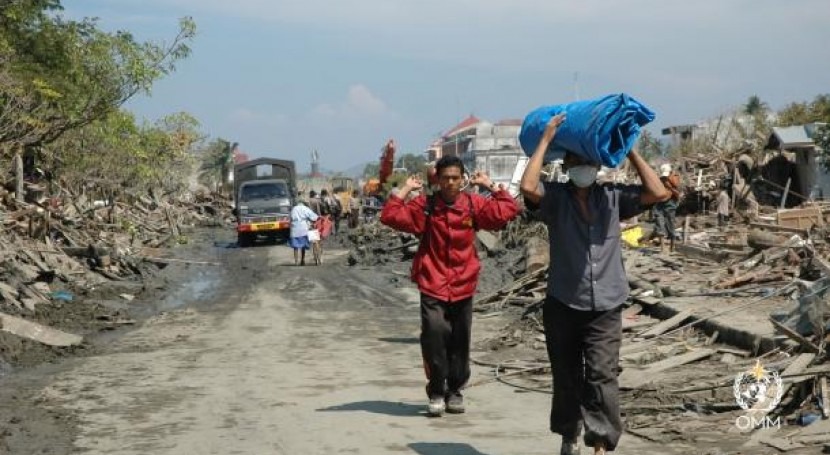Extreme weather, climate and water-related events caused 11 778 reported disasters between 1970 and 2021, with just over 2 million deaths and US$ 4.3 trillion in economic losses, according to a new figure from the World Meteorological Organization (WMO).
Economic losses have soared. But improved early warnings and coordinated disaster management has slashed the human casualty toll over the past half a century. Over 90% of reported deaths worldwide occurred in developing countries.
The USA alone incurred US$1.7 trillion, accounting for 39% of economic losses worldwide in the 51 years. But Least Developed Countries and Small Island Developing States suffered a disproportionately high cost in relation to the size of their economies.
WMO issued the new findings for the quadrennial World Meteorological Congress, which opens on 22 May with a high-level dialogue on accelerating and scaling up action to ensure that early warning services reach everyone on Earth by the end of 2027.
The United Nations Early Warnings for All initiative is one of the top strategic priorities due to be endorsed by the World Meteorological Congress, WMO’s top decision-making body. The high-level session will be opened by Swiss President Alain Berset and brings together top representatives of UN agencies, development banks, governments and national meteorological and hydrological services responsible for issuing early warnings.
“The most vulnerable communities unfortunately bear the brunt of weather, climate and water-related hazards,” said WMO Secretary-General Prof. Petteri Taalas.
“Extremely severe cyclonic storm Mocha exemplifies this. It caused widespread devastation in Myanmar and Bangladesh, impacting the poorest of the poor. In the past, both Myanmar and Bangladesh suffered death tolls of tens and even hundreds of thousands of people. Thanks to early warnings and disaster management these catastrophic mortality rates are now thankfully history. Early warnings save lives.”
WMO compiled the figures as an update to its Atlas of Mortality and Economic Losses from Weather, Climate and Water Extremes, which initially covered the 50-year period 1970-2019, based on Centre for Research on the Epidemiology of Disasters’ (CRED) Emergency Events Database (EM-DAT.
Recorded deaths for 2020 and 2021 (22 608 deaths in total) indicate a further decrease in mortality relative to the annual average of the previous decade. Economic losses increased – most of them attributed to storm category.

Key findings:
- Over sixty percent of economic losses due to weather-, climate- and water-related disasters were reported for developed economies. However, the economic losses were equivalent to less than 0.1% of the gross domestic product (GDP) in respective economies in more than four fifths of these disasters. No disasters were reported with economic losses greater than 3.5% of the respective GDPs.
- In Least Developed Countries, 7% of disasters for which economic losses were reported had an impact equivalent to more than 5% of the respective GDPs, with several disasters causing economic losses up to nearly 30%.
- In Small Island Developing States, 20% of disasters with reported economic losses led to an impact equivalent to more than 5% of the respective GDPs, with some disasters causing economic losses above 100%.

Regional breakdown
Africa: In Africa, 1 839 disasters attributed to weather, climate and water extremes were reported between 1970 and 2021. They caused 733 585 deaths and US$ 43 billion in economic losses. Droughts accounted for 95% of reported deaths.
Tropical cyclone Idai in March 2019 was the costliest event that occurred in Africa (US$2.1 billion)
Asia: There were 3 612 disasters attributed to weather, climate and water extremes were reported, with 984 263 deaths and US$ 1.4 trillion in economic losses
Between 1970 and 2021, Asia accounted for 47% of all reported deaths worldwide, with tropical cyclones being the leading cause of reported deaths. Tropical cyclone Nargis in 2008 led to 138 366 deaths. Bangladesh has highest death toll in Asia with 520 758 deaths due to 281 events.
South America: There were 943 disasters attributed to weather, climate and water extremes reported in South America, with floods accounting for 61% of these. They resulted in 58 484 deaths and US$ 115.2 billion in economic losses.
North America, Central America and Caribbean: A reported 2 107 weather-, climate- and water-related resulted in 77 454 deaths and US$ 2.0 trillion in economic losses.
Between 1970 and 2021, the region accounted for 46% of reported economic losses worldwide. The USA alone incurred US$1.7 trillion, accounting for 39% of losses worldwide in the 51 years. Most of the reported economic losses were attributed to storm-related disasters, and more specifically, to tropical cyclones.
South-West Pacific: There were 1 493 disasters due to weather, climate and water extremes were reported in South-West Pacific. They resulted in 66 951 deaths and US$ 185.8 billion in economic losses. Tropical cyclones were the leading cause of death.
Europe: There were 1 784 disasters causing 166 492 deaths and US$ 562.0 billion in economic losses.
Between 1970 and 2021, Europe accounted for 8% of reported deaths worldwide.
Extreme temperatures were the leading cause of reported deaths and floods were the leading cause of economic losses.

Early Warnings For All
UN Secretary-General António Guterres wants to ensure every person on Earth is protected by early warning systems by the end of 2027.
These are a proven, effective climate adaptation measure, that save lives and provide at least a tenfold return on investment. However, only half of countries have early warning systems in place with coverage especially low in Small Island Developing States (SIDS), Least Developed Countries (LDCs) and in Africa.
The Early Warnings initiative has received broad support. It is spearheaded by WMO, the UN Office for Disaster Risk Reduction, International Telecommunications Union, International Federation of Red Cross and Red Crescent Societies, with support from more than twenty others UN agencies as well as a very wide range of stakeholders, from financial institutions to private sectors.
A first set of 30 countries have been identified for the roll-out of the initiative in 2023.


















